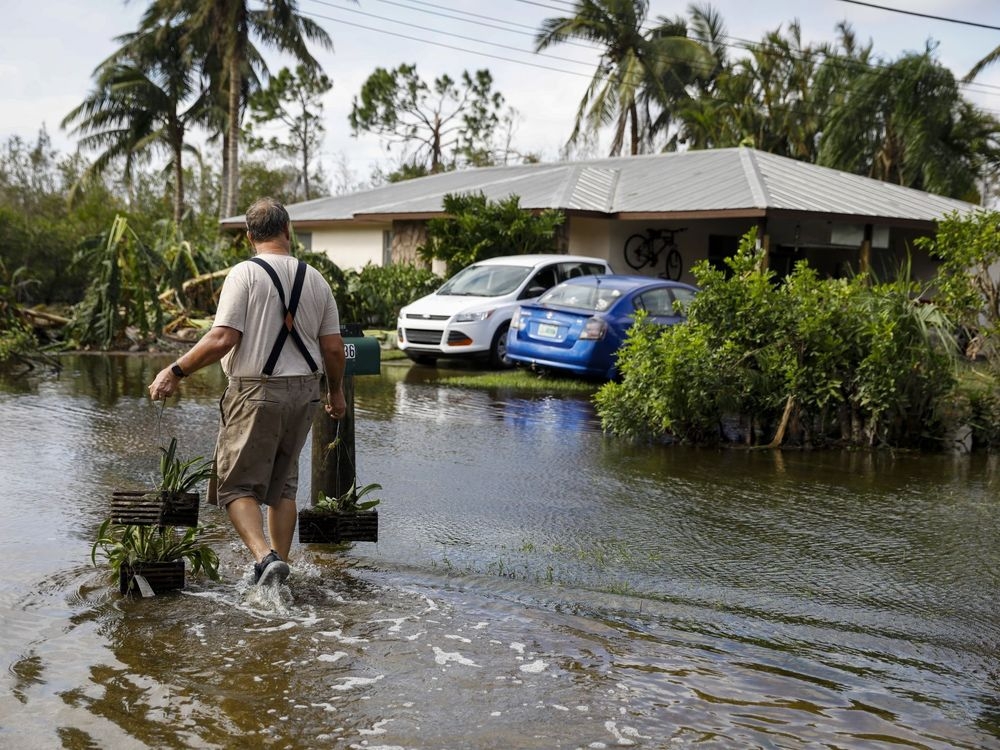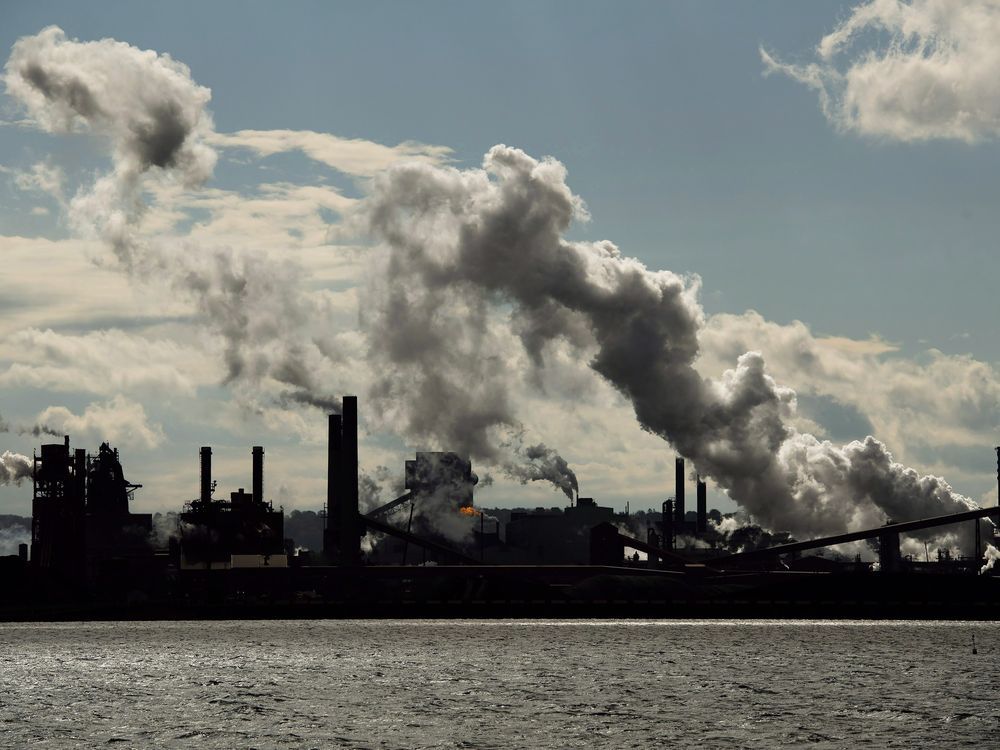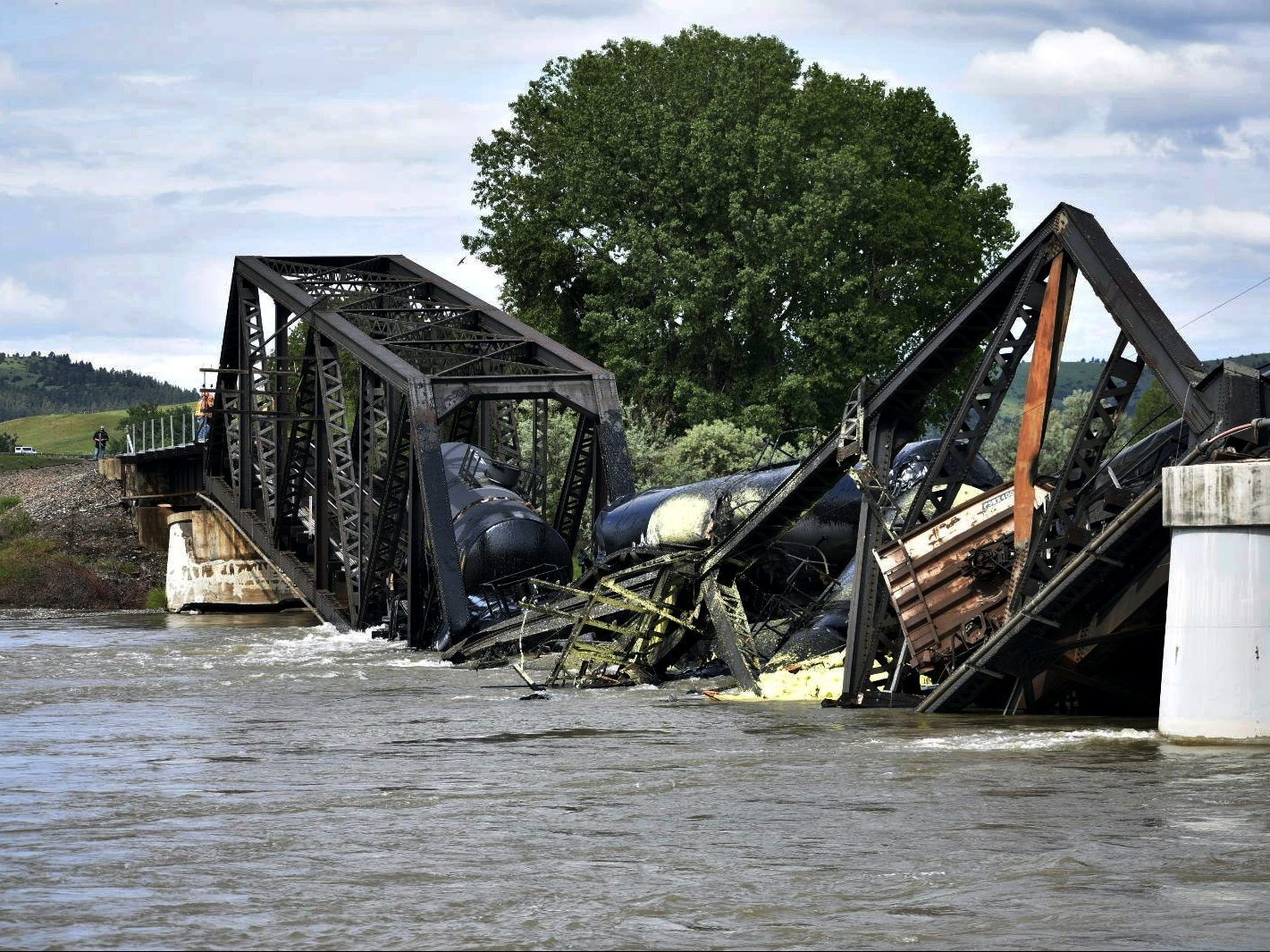its a shitty shituation.Raw sewage swirls into Florida floodwaters in Hurricane Ian's wake
Such discharges can carry bacteria like E. coli, parasites and viruses that can make humans sick
Author of the article:Bloomberg News
Bloomberg News
Ari Natter
Publishing date:Sep 30, 2022 • 1 day ago • 4 minute read • Join the conversation
Floridians reeling from widespread power outages and a deadly surge of water following Hurricane Ian are facing another problem: raw sewage swirling into the floodwaters.
Untold gallons of raw and poorly treated sewage have flowed into streets and rivers as floodwaters inundate infrastructure, power failures knock pumps offline, and manholes overflow.
Such discharges can carry bacteria like E. coli, parasites and viruses that can make humans sick. Nutrients contained in human waste such as phosphorous and nitrogen can also lead to red tides — concentrations of toxic algae — and blue-green algae (cyanobacteria) blooms in ocean waters, which can kill fish and other wildlife. Recent years have seen severe red tides off Florida’s Gulf Coast.
Officials have warned the public to avoid contact with standing water in the vicinity of discharges. Exposure to contaminants in floodwaters may cause skin rashes, gastrointestinal illness and other health problems, according to the Centers for Disease Control and Prevention.
Ian slammed ashore in southwestern Florida as a Category 4 Hurricane, dumping nearly 20 inches of rain in some areas and cutting power to millions.
“Whether it’s the storm surge or just the vast amounts of rain, there is not a sewer system on the planet that can take that kind of hit without having some sort of overflow,” said Nathan Gardner-Andrews, chief advocacy officer for the National Association of Clean Water Agencies. “As storms get more intense you are going to see unfortunately more incidents where systems get overwhelmed.”
Unlike in other parts of the US where sewer systems can use gravity, Florida’s flat topography means a series of lifts and other infrastructure is needed to get wastewater where it needs to go. If those pumps fail or lose power, they overflow, Gardner-Andrews said.
On Thursday afternoon, after a water treatment facility in Bradenton become overwhelmed by stormwater and had to be bypassed, officials were expecting millions of gallons of wastewater to be released into the Manatee River, said William Waitt, the city’s superintendent said, adding the incident was ongoing.
In the Orlando suburb of Casselberry, overflowing tanks at a plant after heavy rains resulted in the discharge of tens of thousands of partially treated waste, said Dawn Swailes, the city’s water reclamation superintendent.
And Ian caused thousands of gallons of sewage to be discharged into a storm drain from an overflowing manhole in Miami, according to a filing with the Florida Department of Environmental Protection, one of dozens of reports of sewage releases the agency received following the storm.
The state’s water and sewer infrastructure “is going to be heavily impacted” by Ian, Brock Long, who previously served as administrator of the Federal Emergency Management Agency, said on Bloomberg Television. “Unfortunately for the citizens that reside down there, they’re going to have to change their mindset and expectations: The infrastructure’s just not going to work for a long time.”
Florida is no stranger to major sewer spills following hurricanes. Hurricane Irma in 2017 led to the discharge of millions of gallons of wastewater, according to a report from the Florida Department of Environmental Protection. The release after Hurricanes Hermine and Matthew in 2016 was even bigger: 250 million gallons.
Part of the problem is that in some areas of the state, like Miami-Dade County and Fort Lauderdale, wastewater infrastructure is old and crumbling and allows torrents of excess groundwater and stormwater into the system, said Brian LaPointe, a research professor at Florida Atlantic University’s Harbor Branch Oceanographic Institute. In some places the pipes used to carry waste are made out of cast iron that corrodes, or even a kind of wood pulp known as Orangeburg, he said.
The US Environmental Protection Agency estimated in 2016 that $271 billion is needed to maintain and improve the nation’s wastewater pipes, treatment plants and associated infrastructure.
In addition to sewer overflows, the contents of some of Florida’s hundreds of thousands of septic tanks will contribute to the human waste flowing into the state’s Caloosahatchee River and eventually into the Gulf of Mexico, LaPointe said.
“I’d say this is going to be unprecedented,” LaPointe said in a phone interview. “We are anticipating seeing a number of these algal blooms in the wake of Hurricane Ian.”
One model the state could look to in the future is in the Florida Keys. Monroe County spent about $1 billion on a septic-to-sewer upgrade that included new, tightly sealed pipes to keep stormwater out and an advanced wastewater treatment system to remove nitrogen, preventing algal blooms that damage coral reefs. The water is then injected more than 3,000 feet underground, LaPointe said. The area reported no sewage spills after Irma, despite being flooded, he added.
“This is really where I think Florida is going to be heading in the future,” LaPointe said. “We are going to have to spend billions of dollars in many of these urban areas.”

Raw sewage swirls into Florida floodwaters in Hurricane Ian's wake
Floridians reeling from widespread power outages and a deadly surge of water following Hurricane Ian are facing another problem: raw sewage.torontosun.com
Water is Life
- Thread starter Cliffy
- Start date
You are using an out of date browser. It may not display this or other websites correctly.
You should upgrade or use an alternative browser.
You should upgrade or use an alternative browser.
Hamilton mayor calls for probe after sewer leak went undetected for 26 years
"While we are not yet aware of the total volume of sewage released, I have been informed that it was substantial"
Author of the article:Canadian Press
Canadian Press
Publishing date:Nov 24, 2022 • 1 day ago • 1 minute read
Hamilton’s mayor has called for an investigation after city staff discovered that a pipe had been dumping sewage into the local harbour undetected for 26 years.
Andrea Horwath said she’s asked the city auditor to be brought in after a preliminary investigation of the leak suggested a contractor put a hole in the pipe in 1996.
“I am concerned about the environmental impacts of this spill, and while we are not yet aware of the total volume of sewage released, I have been informed that it was substantial,” Horwath wrote in a statement released Tuesday.
“I was assured that the nature of the spill makes the risk to human health very low.”
Horwath said she has asked the city auditor to investigate how the spill was able to persist for more than 20 years without detection.
“I expect that when that report is completed, it will be publicly released,” she said.
The city said in a written statement that the pipe involved services about 50 properties, which have been flushing directly into the Hamilton Harbour. It said the leak was discovered in a stretch of pipe near Burlington Street and Wentworth Street North by staff doing separate maintenance work.
It said it believes a contractor made the hole in the pipe under the impression that “all pipes were storm sewers” designed to connect to culverts spilling into the harbour.
The city said it took short-term action to stem the flow of sewage from the leak.
Once its assessment is finished, the city said it will publicly report how much sewage the pipe has dumped.
“Residents in the area can expect to see a high level of activity in the area over the next few days with trucks and other vehicles as staff work to mitigate the current leak and begin work to make the necessary repairs,” said the city statement.

 torontosun.com
torontosun.com

"While we are not yet aware of the total volume of sewage released, I have been informed that it was substantial"
Author of the article:Canadian Press
Canadian Press
Publishing date:Nov 24, 2022 • 1 day ago • 1 minute read
Hamilton’s mayor has called for an investigation after city staff discovered that a pipe had been dumping sewage into the local harbour undetected for 26 years.
Andrea Horwath said she’s asked the city auditor to be brought in after a preliminary investigation of the leak suggested a contractor put a hole in the pipe in 1996.
“I am concerned about the environmental impacts of this spill, and while we are not yet aware of the total volume of sewage released, I have been informed that it was substantial,” Horwath wrote in a statement released Tuesday.
“I was assured that the nature of the spill makes the risk to human health very low.”
Horwath said she has asked the city auditor to investigate how the spill was able to persist for more than 20 years without detection.
“I expect that when that report is completed, it will be publicly released,” she said.
The city said in a written statement that the pipe involved services about 50 properties, which have been flushing directly into the Hamilton Harbour. It said the leak was discovered in a stretch of pipe near Burlington Street and Wentworth Street North by staff doing separate maintenance work.
It said it believes a contractor made the hole in the pipe under the impression that “all pipes were storm sewers” designed to connect to culverts spilling into the harbour.
The city said it took short-term action to stem the flow of sewage from the leak.
Once its assessment is finished, the city said it will publicly report how much sewage the pipe has dumped.
“Residents in the area can expect to see a high level of activity in the area over the next few days with trucks and other vehicles as staff work to mitigate the current leak and begin work to make the necessary repairs,” said the city statement.

Hamilton mayor calls for probe after sewer leak went undetected for 26 years
City staff discovered that a pipe had been dumping sewage into the local harbour undetected for 26 years.
Hamilton sewage pipe leaked up to 337M litres into harbour, says city report
Author of the article:Antonella Artuso
Publishing date:Nov 28, 2022 • 20 hours ago • 2 minute read
As much as 337 million litres of sewage flowed into Hamilton Harbour over 26 years due to a hole in a combined sewer pipe.
Hamilton Mayor Andrea Horwath has asked the city auditor to investigate how a sewage leak in Hamilton could go undetected for more than 20 years
As much as 337 million litres of sewage flowed into Hamilton Harbour over 26 years due to a hole in a combined sewer pipe.
The City of Hamilton said municipal officials estimated the size of the leak based on the water use of connected properties.
“The repair work and realignment of the sewer was completed on Wednesday, Nov. 23, 2022 at 9:32 p.m., and all sewage is now flowing into the Western Sanitary Interceptor and all appropriate repairs to the combined sewer have been completed,” a city statement released Monday says. “The catchment area for the combined sewer system services is approximately 50 properties that are tied into the pipe.”
The bill for repairing the pipe was $29,830, not including staff time.
City workers conducted a preliminatry investigation and now believe the hole was created in the combined sewer pipe in late 1996.
“A contractor completing work on a city project was under the impression that all pipes in the area were storm sewers and were designed to directly connect to box culverts leading out to the harbour,” the city statement says.
Mayor Andrea Horwath has asked the city auditor to investigate how a spill of this nature could go undetected for more than 20 years and has promised the completed report will be publicly released.
“I am concerned about the environmental impacts of this spill, and while we are not yet aware of the total volume of sewage released, I have been informed that it was substantial,” Horwath said in an earlier statement. “I was assured that the nature of the spill makes the risk to human health very low.”
Ontario Environment Minister David Piccini has called the leak unacceptable and is ordering Hamilton to audit its entire sewage system.
Hamilton Water is responsible for more than 1,268 kilometres of sanitary sewers and 573 kilometres of combined sewers.
“During wet weather, flows can exceed the capacity of the combined sewer system and combined sewage overflows into local creeks and streams,” the city statement says. “These overflows are necessary in order to prevent basement flooding and to protect the Woodward Avenue wastewater treatment plant against overloading. In 2021, the average volume of combined sewage discharged from the Wentworth combined sewer outfall untreated was 17,394,000 litres per event.”
aartuso@postmedia.com

 torontosun.com
torontosun.com

Author of the article:Antonella Artuso
Publishing date:Nov 28, 2022 • 20 hours ago • 2 minute read
As much as 337 million litres of sewage flowed into Hamilton Harbour over 26 years due to a hole in a combined sewer pipe.
Hamilton Mayor Andrea Horwath has asked the city auditor to investigate how a sewage leak in Hamilton could go undetected for more than 20 years
As much as 337 million litres of sewage flowed into Hamilton Harbour over 26 years due to a hole in a combined sewer pipe.
The City of Hamilton said municipal officials estimated the size of the leak based on the water use of connected properties.
“The repair work and realignment of the sewer was completed on Wednesday, Nov. 23, 2022 at 9:32 p.m., and all sewage is now flowing into the Western Sanitary Interceptor and all appropriate repairs to the combined sewer have been completed,” a city statement released Monday says. “The catchment area for the combined sewer system services is approximately 50 properties that are tied into the pipe.”
The bill for repairing the pipe was $29,830, not including staff time.
City workers conducted a preliminatry investigation and now believe the hole was created in the combined sewer pipe in late 1996.
“A contractor completing work on a city project was under the impression that all pipes in the area were storm sewers and were designed to directly connect to box culverts leading out to the harbour,” the city statement says.
Mayor Andrea Horwath has asked the city auditor to investigate how a spill of this nature could go undetected for more than 20 years and has promised the completed report will be publicly released.
“I am concerned about the environmental impacts of this spill, and while we are not yet aware of the total volume of sewage released, I have been informed that it was substantial,” Horwath said in an earlier statement. “I was assured that the nature of the spill makes the risk to human health very low.”
Ontario Environment Minister David Piccini has called the leak unacceptable and is ordering Hamilton to audit its entire sewage system.
Hamilton Water is responsible for more than 1,268 kilometres of sanitary sewers and 573 kilometres of combined sewers.
“During wet weather, flows can exceed the capacity of the combined sewer system and combined sewage overflows into local creeks and streams,” the city statement says. “These overflows are necessary in order to prevent basement flooding and to protect the Woodward Avenue wastewater treatment plant against overloading. In 2021, the average volume of combined sewage discharged from the Wentworth combined sewer outfall untreated was 17,394,000 litres per event.”
aartuso@postmedia.com

Hamilton sewage pipe leaked up to 337M litres into harbour, says city report
As much as 337 million litres of sewage flowed into Hamilton Harbour over 26 years due to a hole in a combined sewer pipe.
Hamilton uncovers another decades-old leak dumping sewage into Lake Ontario
Author of the article:Canadian Press
Canadian Press
Published Jan 10, 2023 • 1 minute read
The City of Hamilton says it has uncovered another sewage leak that has been dumping waste into Lake Ontario for more than two decades.
The revelation comes after the city reported in November that a leak discovered to be from 1996 had dumped 337 million litres of sewage into the Hamilton harbour in the 26 years it went undetected.
The city says it confirmed the latest leak — also believed to present since 1996 — on Monday following an investigation into the previous leak.
It says the investigation shows as many as 11 residential properties have been discharging wastewater into the local harbour since 1996, when a 100-year-old combined sewer pipe was connected to a newly constructed storm sewer.
The city says staff are not currently aware of how much sewage has been dumped into the harbour since then, but pledge to report the number when an assessment is complete.
The city says the latest leak was found as part of a pilot program that inspects areas of the sewer system where the same cross connections responsible for the leak uncovered in November could be present.

 torontosun.com
torontosun.com

Author of the article:Canadian Press
Canadian Press
Published Jan 10, 2023 • 1 minute read
The City of Hamilton says it has uncovered another sewage leak that has been dumping waste into Lake Ontario for more than two decades.
The revelation comes after the city reported in November that a leak discovered to be from 1996 had dumped 337 million litres of sewage into the Hamilton harbour in the 26 years it went undetected.
The city says it confirmed the latest leak — also believed to present since 1996 — on Monday following an investigation into the previous leak.
It says the investigation shows as many as 11 residential properties have been discharging wastewater into the local harbour since 1996, when a 100-year-old combined sewer pipe was connected to a newly constructed storm sewer.
The city says staff are not currently aware of how much sewage has been dumped into the harbour since then, but pledge to report the number when an assessment is complete.
The city says the latest leak was found as part of a pilot program that inspects areas of the sewer system where the same cross connections responsible for the leak uncovered in November could be present.

Hamilton uncovers another decades-old leak dumping sewage into Lake Ontario
The City of Hamilton says it has uncovered another sewage leak that has been dumping waste into Lake Ontario for more than two decades.
Nearly 95,000 pieces of plastic were removed from Toronto Harbour in four months
Author of the article enette Wilford
enette Wilford
Published Feb 08, 2023 • 1 minute read
It takes a village – in this case, Ports Toronto and the University of Toronto’s Trash Team.
Toronto’s Harbour is now free of nearly 100,000 pieces of plastic, thanks to Ports Toronto’s Trash Trapping Program Network and the student researchers whose mission it is to increase waste literacy in the community while reducing plastic pollution in our ecosystems.
Ports’ Seabins program did much of the work, though, as the 10 bins diverted 92,891 small pieces of plastic pollution from the bay from May to September last year.
The microplastics found (so, items smaller than five millimetres) were the most common amid the debris, but there was also 18 kilograms of “anthropogenic” (think human-related debris) items that were recovered.
Those items included hundreds to thousands of pieces of hard plastic fragments broken off from larger plastic items, food wrappers, cigarette butts, bottle caps, cigar tips and plastic straws.
Among the large items found were more than 100 “fatbergs,” which are described as “rock-like masses formed by the combination of fat, grease and wastewater materials,” like diapers and wet wipes.
Ports Toronto hopes residents will reconsider what they wash down the drain after witnessing the “troubling rise in plastic solution” that “threatens the sustainability and biodiversity of our lakes and waterways,” according to RJ Steenstra, President and CEO, PortsToronto.
Dr. Chelsea Rochman, Head of Operations at the U of T Trash Team, is hopeful and calls 2022 “a big year” for the study which deployed research assistants who worked daily through the summer to empty, quantify and characterize what was recovered in the Seabins.
“Their positive impact helps remove litter and synthesize data that can be used to inform upstream policies to reduce plastic pollution.”

 torontosun.com
torontosun.com
Author of the article
Published Feb 08, 2023 • 1 minute read
It takes a village – in this case, Ports Toronto and the University of Toronto’s Trash Team.
Toronto’s Harbour is now free of nearly 100,000 pieces of plastic, thanks to Ports Toronto’s Trash Trapping Program Network and the student researchers whose mission it is to increase waste literacy in the community while reducing plastic pollution in our ecosystems.
Ports’ Seabins program did much of the work, though, as the 10 bins diverted 92,891 small pieces of plastic pollution from the bay from May to September last year.
The microplastics found (so, items smaller than five millimetres) were the most common amid the debris, but there was also 18 kilograms of “anthropogenic” (think human-related debris) items that were recovered.
Those items included hundreds to thousands of pieces of hard plastic fragments broken off from larger plastic items, food wrappers, cigarette butts, bottle caps, cigar tips and plastic straws.
Among the large items found were more than 100 “fatbergs,” which are described as “rock-like masses formed by the combination of fat, grease and wastewater materials,” like diapers and wet wipes.
Ports Toronto hopes residents will reconsider what they wash down the drain after witnessing the “troubling rise in plastic solution” that “threatens the sustainability and biodiversity of our lakes and waterways,” according to RJ Steenstra, President and CEO, PortsToronto.
Dr. Chelsea Rochman, Head of Operations at the U of T Trash Team, is hopeful and calls 2022 “a big year” for the study which deployed research assistants who worked daily through the summer to empty, quantify and characterize what was recovered in the Seabins.
“Their positive impact helps remove litter and synthesize data that can be used to inform upstream policies to reduce plastic pollution.”

Nearly 95,000 pieces of plastic were removed from Toronto Harbour in four months
Toronto’s Harbour is now free of nearly 100,000 pieces of plastic, thanks to Ports Toronto and the University of Toronto’s Trash Team.
There is no "step up" from Hamlet. Not even Trailer Park Boys.It's a step up from the hamlet of the previous decade.
Freight train carrying hazardous materials plunges into Yellowstone River as bridge fails
Author of the article:Associated Press
Associated Press
Matthew Brown and Gene Johnson
Published Jun 24, 2023 • Last updated 2 days ago • 2 minute read
COLUMBUS, Mont. — A bridge that crosses the Yellowstone River in Montana collapsed early Saturday, plunging portions of a freight train carrying hazardous materials into the rushing water below.
The train cars were carrying hot asphalt and molten sulfur, Stillwater County Disaster and Emergency Services said. Officials shut down drinking water intakes downstream while they evaluated the danger after the 6 a.m. accident. An Associated Press reporter witnessed a yellow substance coming out of some of the tank cars.
David Stamey, the county’s chief of emergency services, said there was no immediate danger for the crews working at the site, and the hazardous material was being diluted by the swollen river. There were three asphalt cars and four sulfur cars in the river.
The train crew was safe and no injuries were reported, Montana Rail Link spokesman Andy Garland said in a statement. The asphalt and sulfur both solidify quickly when exposed to cooler temperatures, he said.
Railroad crews were at the scene in Stillwater County, near the town of Columbus, about 64 kilometres west of Billings. The area is in a sparsely populated section of the Yellowstone River Valley, surrounded by ranch and farmland. The river there flows away from Yellowstone National Park, which is about 177 kilometres southwest.
“We are committed to addressing any potential impacts to the area as a result of this incident and working to understand the reasons behind the accident,” Garland said.
In neighbouring Yellowstone County, officials said they instituted emergency measures at water treatment plants due to the “potential hazmat spill” and asked residents to conserve water.
The cause of the collapse is under investigation. The river was swollen with recent heavy rains, but it’s unclear whether that was a factor.
The Yellowstone saw record flooding in 2022 that caused extensive damage to Yellowstone National Park and adjacent towns in Montana. Robert Bea, a retired engineering professor at the University of California Berkeley who has analyzed the causes of hundreds of major disasters, said repeated years of heavy river flows provided a clue to the possible cause.
“The high water flow translates to high forces acting directly on the pier and, importantly, on the river bottom,” Bea said. “You can have erosion or scour that removes support from the foundation. High forces translate to a high likelihood of a structural or foundation failure that could act as a trigger to initiate the accident.”
Bea said investigators would also want to look at whether there was wear or rust in bridge components as well as a record of maintenance, repair and inspections.
Federal Railroad Administration officials were at the scene.
Kelly Hitchcock of the Columbus Water Users shut off the flow of river water into an irrigation ditch downstream from the collapsed bridge to prevent contents from the tank cars from reaching nearby farmland. The Stillwater County Sheriff’s Office called the group Saturday morning to warn it about the collapse, Hitchcock said.
The U.S. Environmental Protection Agency notes that sulfur is a common element used as a fertilizer as well as an insecticide, fungicide and rodenticide.
— Johnson reported from Seattle.

 torontosun.com
torontosun.com
Author of the article:Associated Press
Associated Press
Matthew Brown and Gene Johnson
Published Jun 24, 2023 • Last updated 2 days ago • 2 minute read
COLUMBUS, Mont. — A bridge that crosses the Yellowstone River in Montana collapsed early Saturday, plunging portions of a freight train carrying hazardous materials into the rushing water below.
The train cars were carrying hot asphalt and molten sulfur, Stillwater County Disaster and Emergency Services said. Officials shut down drinking water intakes downstream while they evaluated the danger after the 6 a.m. accident. An Associated Press reporter witnessed a yellow substance coming out of some of the tank cars.
David Stamey, the county’s chief of emergency services, said there was no immediate danger for the crews working at the site, and the hazardous material was being diluted by the swollen river. There were three asphalt cars and four sulfur cars in the river.
The train crew was safe and no injuries were reported, Montana Rail Link spokesman Andy Garland said in a statement. The asphalt and sulfur both solidify quickly when exposed to cooler temperatures, he said.
Railroad crews were at the scene in Stillwater County, near the town of Columbus, about 64 kilometres west of Billings. The area is in a sparsely populated section of the Yellowstone River Valley, surrounded by ranch and farmland. The river there flows away from Yellowstone National Park, which is about 177 kilometres southwest.
“We are committed to addressing any potential impacts to the area as a result of this incident and working to understand the reasons behind the accident,” Garland said.
In neighbouring Yellowstone County, officials said they instituted emergency measures at water treatment plants due to the “potential hazmat spill” and asked residents to conserve water.
The cause of the collapse is under investigation. The river was swollen with recent heavy rains, but it’s unclear whether that was a factor.
The Yellowstone saw record flooding in 2022 that caused extensive damage to Yellowstone National Park and adjacent towns in Montana. Robert Bea, a retired engineering professor at the University of California Berkeley who has analyzed the causes of hundreds of major disasters, said repeated years of heavy river flows provided a clue to the possible cause.
“The high water flow translates to high forces acting directly on the pier and, importantly, on the river bottom,” Bea said. “You can have erosion or scour that removes support from the foundation. High forces translate to a high likelihood of a structural or foundation failure that could act as a trigger to initiate the accident.”
Bea said investigators would also want to look at whether there was wear or rust in bridge components as well as a record of maintenance, repair and inspections.
Federal Railroad Administration officials were at the scene.
Kelly Hitchcock of the Columbus Water Users shut off the flow of river water into an irrigation ditch downstream from the collapsed bridge to prevent contents from the tank cars from reaching nearby farmland. The Stillwater County Sheriff’s Office called the group Saturday morning to warn it about the collapse, Hitchcock said.
The U.S. Environmental Protection Agency notes that sulfur is a common element used as a fertilizer as well as an insecticide, fungicide and rodenticide.
— Johnson reported from Seattle.

Freight train carrying hazardous materials plunges into Yellowstone River as bridge fails
A bridge that crosses Yellowstone River in Montana collapsed, causing portions of a freight train to plunge into the water below.